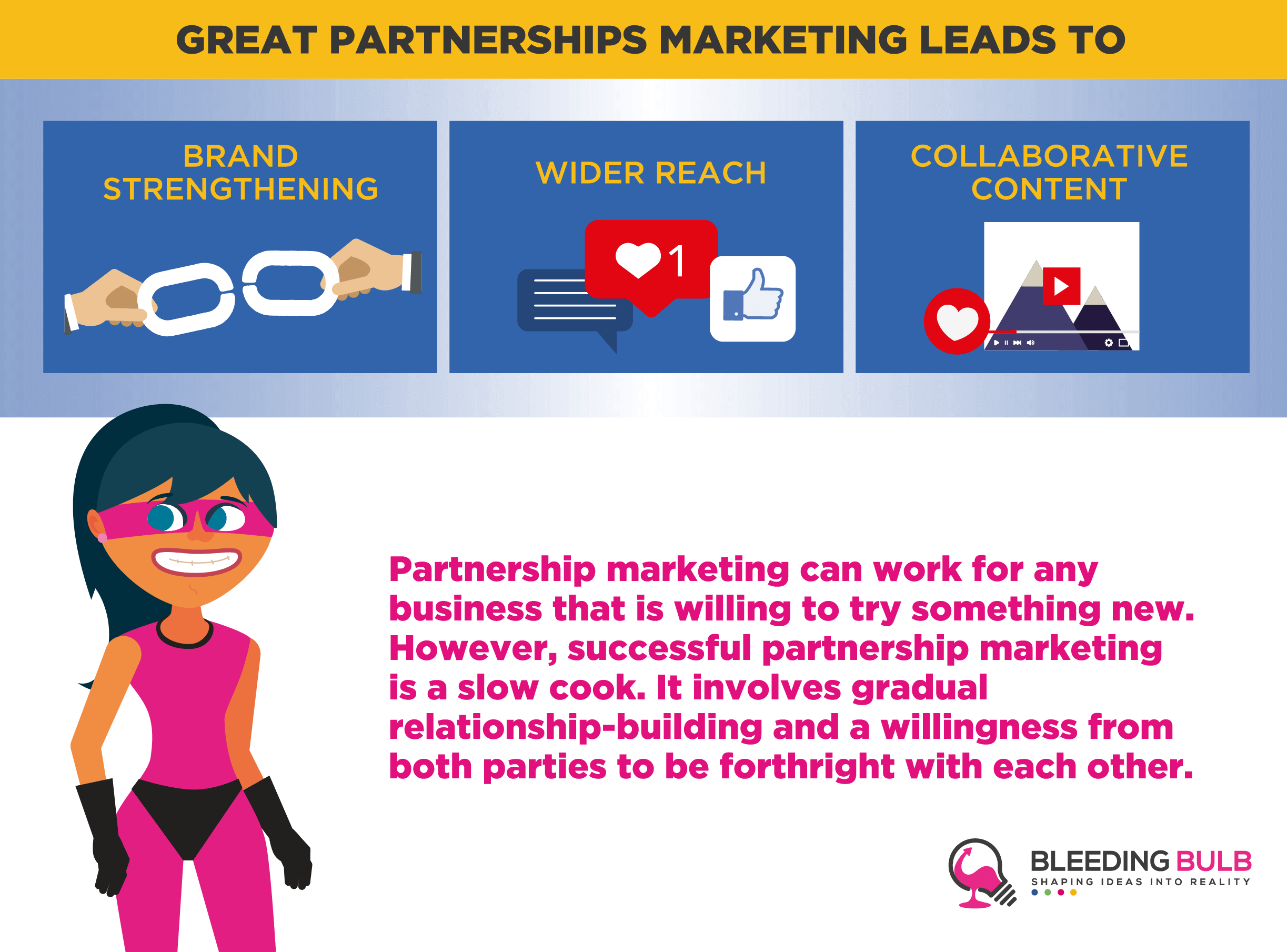Why Relationships Matter in Business
What is Partnership Marketing?
10 Types of Partnership Marketing (With Examples)
Advantages of Partnership Marketing
Disadvantages of Partnership Marketing
Will Partnership Marketing Work for Your Business?
Creating a Partnership Marketing Plan
Where and How to Find Marketing Partners
How to Work with Marketing Partners
How to Measure and Manage Partnership Marketing Results
Introduction
As a small business owner, marketing is a key part of your daily work. Your business growth largely hinges on marketing, meaning you will spend a lot of time thinking of how to market your business more effectively. Advertising, content marketing, social media marketing, affiliate marketing – the list of ways to market is long, but also complex. Each type of marketing has variables upon variables, not to mention the amount of time and money you must spend on each to make it work. In this guide, we explore partnership marketing; an effective yet often underutilized type of marketing that can help your business grow significantly, while keeping your costs low.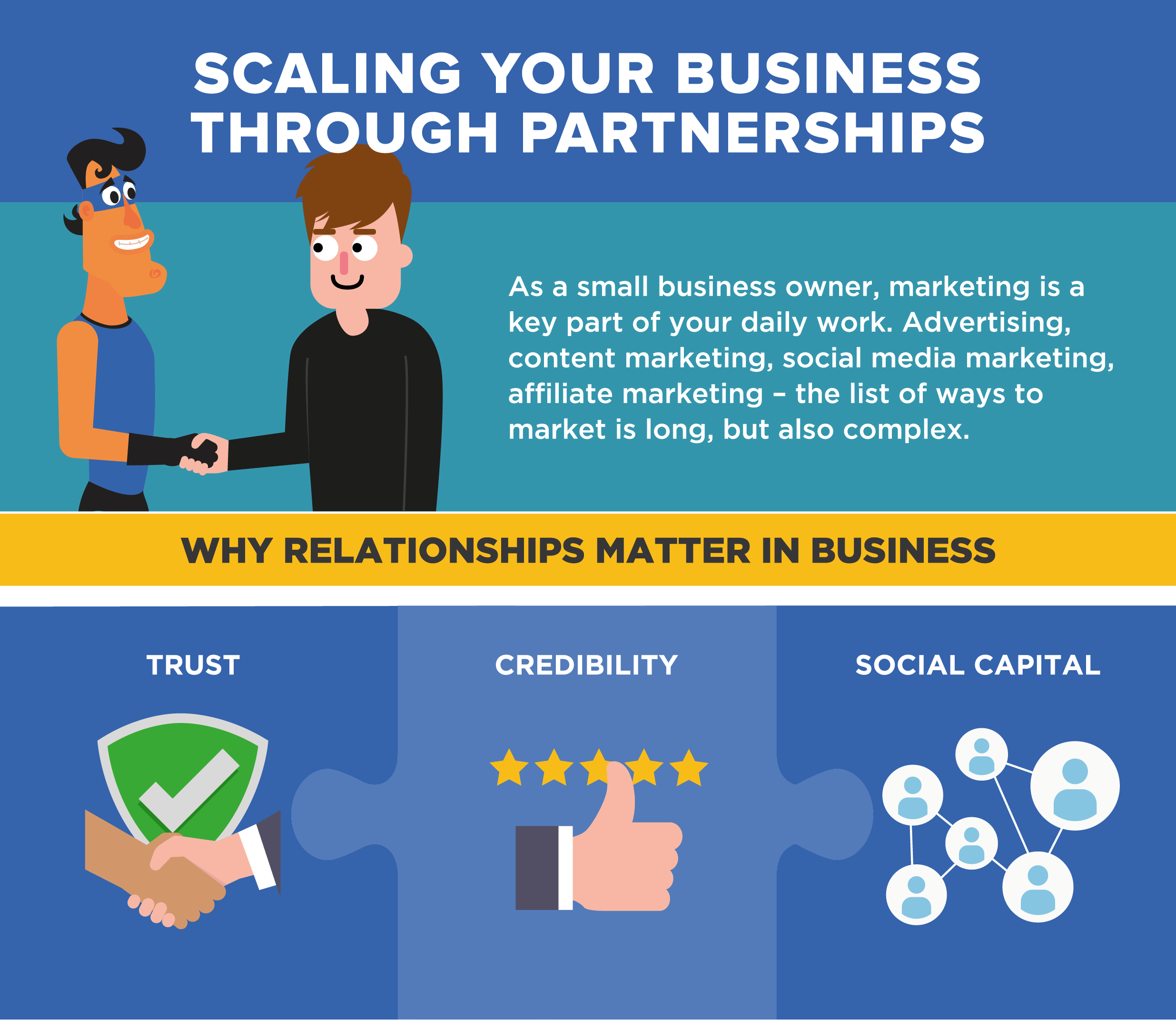
Why Relationships Matter in Business
People do business with each other because there are clear, fundamental aspects that guide their interactions. When you have a leaking tap and call in your regular plumber, your existing relationship assumes they will get the job done on time and on budget. However, if you call in a new plumber, you will probably supervise the work from start to finish. What’s the difference? You have a relationship with your regular plumber and none with the new one. Let’s break down business relationships into three key components: trust, credibility and social capital.Trust
Zig Ziglar, salesman, author, and motivational speaker, once said:
“If they like you, they will listen to you. If they trust you, they will do business with you.”
All your customers do business with you because they trust you. They trust that you are giving them value for their money. They trust that you are an honest person. They trust that you have their best interests at heart. When that trust becomes eroded, or your competitors cultivate deeper trust, you lose business. As such, trust is the most important component of business relationships.
Credibility
While trust is one-on-one, “Do I trust this business enough to buy from them?”; credibility is one-to-many, “Do enough people trust this business for me to buy from them?” You can think of credibility as the total of all the customer interactions you have had, good and bad. When people ask around about your business, what they hear will either establish your credibility or diminish it. Developing strong relationships with everyone that interacts with your business boosts your credibility and creates a strong brand that people can trust.
Social Capital
Relationships are important because they build social capital. While credibility has a lot to do with trust, social is all about connections. When your business has strong social capital, a community of people (network, fans) rallies around your brand. Such people recommend your products to family, friends, and strangers. They are also ready to buy anything you release because they believe in you. Nike has such strong social capital that every new shoe they release is an instant hit among their fans.
As you can see, relationships in business matter a lot. How does this relate to partnership marketing? We cover this in the next section.What is Partnership Marketing?
Partnership marketing is when one business collaborates with another in a marketing effort to the mutual benefit of both parties. One of the most popular examples is affiliate marketing. Although not the only type of partnership marketing, it best illustrates what the concept is. In affiliate marketing, a business partners with another business, known as an affiliate. The affiliate markets the business’s products in exchange for a small commission for every sale made. For example, a business that sells abstract art t-shirts can partner with a blogger (affiliate) who blogs about abstract art. When people interested in abstract art visit the blogger’s site, they see a link to buy an abstract art t-shirt. When they click and make a purchase, the t-shirt company makes a sale, and the blogger (affiliate) earns a commission. In this case, the abstract art t-shirt company has a mutually beneficial partnership marketing agreement with the blogger. Needless to say, partnership marketing is much broader than this simplified illustration. Partnership marketing, sometimes referred to as partnership brand marketing, encompasses influencer marketing, partnership content marketing, joint product marketing, and others. We will cover them in detail in the next section. As a small business, this variety of options creates multiple opportunities to reach new audiences, while leveraging the networks of the businesses you partner with. At the core of partnership marketing, however, are relationships. To successfully run partnership marketing campaigns, you must create and cultivate strong relationships with your partners. With that in mind, let’s now look at the ten types of partnership marketing.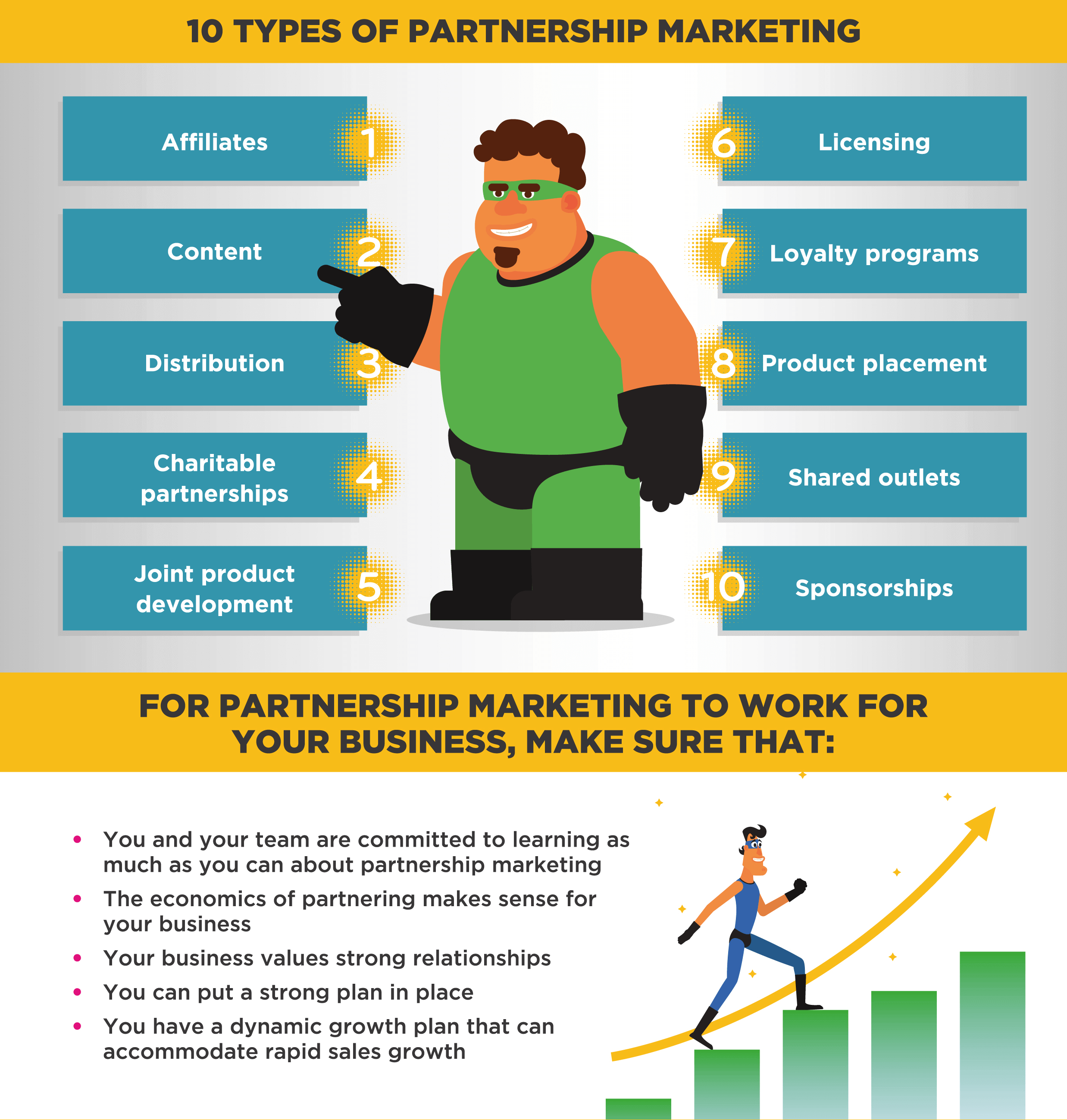
10 Types of Partnership Marketing
Depending on your type of business and your marketing objectives, picking the right type of partnership marketing can help you reach your goals faster. That said, here are the top ten types of partnership marketing:1) Affiliates
A type of performance marketing, affiliate marketing rewards marketing partners (affiliates) with a commission for delivering certain predefined results (traffic, sales, leads). Influencer marketing is one such example, where a business works with a popular online personality (influencer) to drive sales or brand awareness. In such a case, the influencer acts as an affiliate.
2) Content
Through co-creation, cross-publishing or link sharing, partners use content to promote each other’s businesses online and offline. The partnership between Airbnb and Flipboard is one example of a content marketing partnership.
3) Distribution
Strategies like product bundling or cross-marketing allow partners to reach each other’s customers with new complementary products. Dropbox offering free storage to Samsung smartphone customers illustrates this type of partnership.
4) Charitable partnerships
In such a partnership, a business partners with a charitable organization to boost the visibility of both brands. The collaboration between BuzzFeed and the Best Friends Animal Society is an example of such a partnership.
5) Joint product development
Here, two businesses integrate their products into one product. For example, a cheese company may partner with a pizza outlet to create a branded signature pizza.
6) Licensing
By licensing a logo, feature, or any other component, the licensor and the licensee can each benefit. Mastercard’s partnership with Apple (Apple Pay) is a great example of how licensing can benefit both parties.
7) Loyalty programs
In such a partnership, two or more businesses partner to offer a loyalty program to their common customers. Frequent flyer miles are an example of a loyalty program agreement among airlines.
8) Product placement
In this arrangement, a business agrees to feature another business’s products alongside its own. West Elm, a furniture store that does not manufacture mattresses, features mattresses from Leesa and Robin in its stores and on its website.
9) Shared outlets
Similar to product placement, shared outlets go a step further to create co-branded stores either online or offline. Branded shops within supermarkets offer a great example of such a partnership.
10) Sponsorships
Two brands form a partnership where one brand sponsors an event or product offered by the other business. Companies like General Motors do this all the time when they provide vehicles for movie studios.
Which of these partnership approaches do you see working well for your business? Be sure to do more research on each of them before picking one to run with.Advantages of Partnership Marketing
Partnership marketing holds numerous advantages for both small businesses and large ones. In this section, we look at the top five advantages for small businesses.Increased market reach
As a small business, your market reach is often limited to the geographical area you operate in. Through partnership marketing, you can broaden this reach to include either adjacent areas (towns, cities) or online audiences who may live far from your business but may be interested in your products.
Save money
Every small business owner knows that ads are an expensive and unsustainable way to grow a business. Through mutually beneficial marketing partnerships, you can either spend nothing upfront (e.g., affiliate marketing) or share the cost with your partners (e.g. co-sponsorship or joint product promotion).
Brand development
If you partner with a business that has a stronger brand than yours, you can benefit from its brand appeal. This works especially well for small businesses that may not have a strong brand in place.
New marketing ideas
Marketing partners can bring new ideas and strategies to the table. As you partner with multiple businesses, your stockpile of ideas will only grow, helping you launch more diversified and creative marketing campaigns.
Encourages strong organic growth
When you run a Facebook ad, you get instant hits to your website, but often very few conversions. This is artificial growth. Partnership marketing, while slower, results in strong, organic, and long-lasting growth. It helps establish your business as both a reputable brand and a profitable business.
As a small business owner, you can probably already see how each of these five advantages can help your business. Partnership marketing can help grow your brand, bring in more sales, and lower your marketing costs. To give you a balanced perspective of partnership marketing, we will now cover the potential downsides.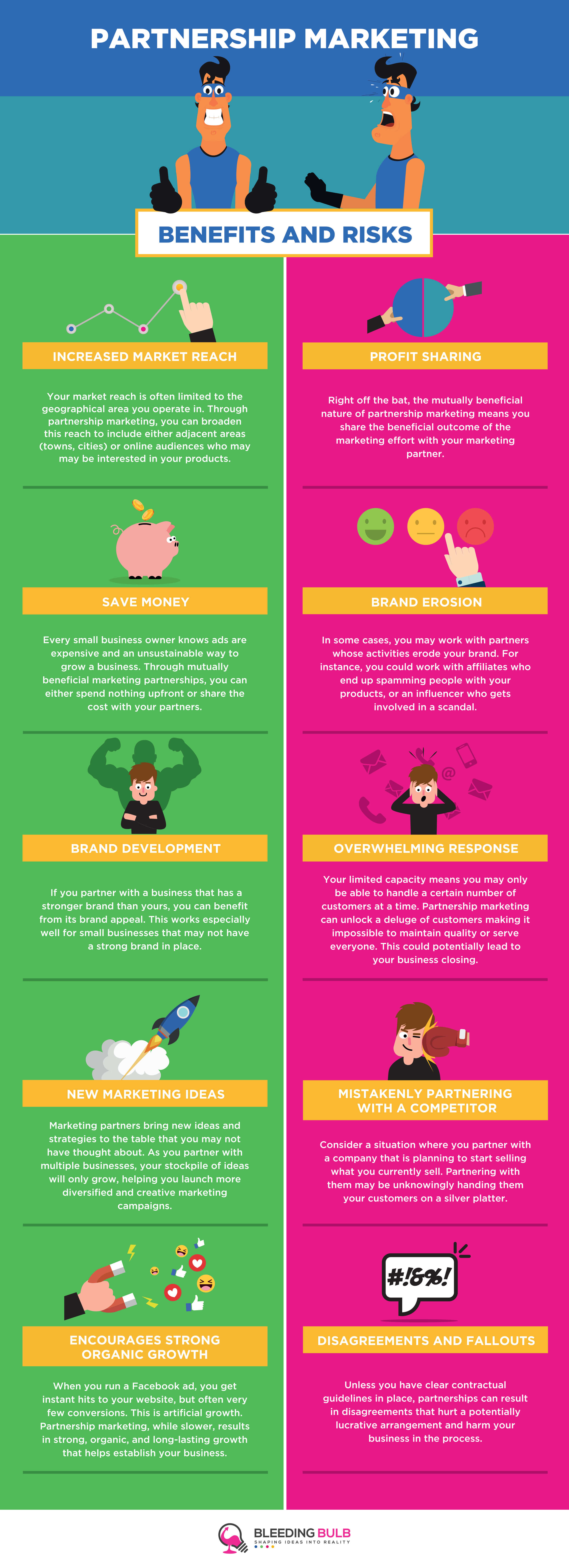 Disadvantages of Partnership Marketing
Disadvantages of Partnership Marketing
While partnership marketing has many strong advantages, there are several potential disadvantages you must be aware of. Here are the top five disadvantages of partnership marketing:
Profit sharing
Right off the bat, the mutually beneficial nature of partnership marketing means you share the beneficial outcomes with your marketing partner. If you are working with affiliates or influencers, you are sharing revenue; if you are working with co-sponsors or supporting a charitable event, you are sharing the publicity.
Brand erosion
In some cases, you may work with partners whose activities erode your brand. For instance, you could work with affiliates who end up spamming people with your products, or an influencer who gets involved in a scandal. As the brand owner, your business will suffer most from this, not the affiliates.
Overwhelming response
As a small business, your limited capacity means you may only be able to handle a certain number of customers at a time. Partnership marketing can unlock a deluge of customers (think of a small burger joint going viral) making it impossible to maintain quality or serve everyone.
Mistakenly partnering with a competitor
Consider a situation where you partner with a company that plans to start selling what you currently sell. By partnering with them, you may be handing them your customer base on a silver platter.
Disagreements and fallouts
Unless you have clear contractual guidelines in place, partnerships can result in disagreements that hurt a potentially lucrative arrangement, and harm your business in the process. Think of a key influencer you are working with who suddenly demands a bigger commission.
Partnership marketing, though risky, can be managed by having a good plan in place. It is also essential to first do your due diligence before engaging with potential partners. In the next section, we answer a crucial question most small business owners ask - “Will partnership marketing work for my small business?”Will Partnership Marketing Work for Your Small Business?
Like most types of marketing, partnership marketing will not work for everyone. Different businesses are at different points in the growth cycle, have different priorities, different resource levels, and so on. Determining whether partnership marketing will work for your small business involves looking at these different dynamics. Here are some important pointers to look for:1) You and your team are committed to learning as much as you can about partnership marketing
Though seemingly simple, partnership marketing, done right, is a complex science. To run successful partnership marketing campaigns will need you and your team to have a strong understanding of the concept, while also staying open and willing to keep learning.
2) The economics of partnering makes sense for your business
Partnership marketing involves a lot of expenditure. You will need to work out how much commission to pay out against revenues, what your cost-per-sale and cost of publicity is, along with a host of other calculations. You should also determine whether potential partners will drive enough revenue to justify the effort. If all the numbers make sense, then your business is ready to partner up.
3) Your business values strong relationships
Does your business value relationships? Is relationship-building a strong part of the culture you aggressively pursue as a business? Partnership marketing requires strong relationship-building skills, which ensure partnerships stick, and remain strong.
4) You can put a strong plan in place
Partnership marketing can quickly get messy without proper structures and guidelines in place. Do you have the skills, time and other resources to create and implement a strong partnership marketing plan? One that keeps everyone on the same page while tracking progress.
5) You have a dynamic growth plan that can accommodate rapid sales growth
Partnership marketing can result in rapid sales growth. Does your business have the capacity to handle such growth? If your business does go viral, will you have access to lines of credit and other facilities you will need to meet aggressive delivery targets?
It may not matter what type of business you are in, but these criteria offer a clear picture of what kind of business is ready to undertake partnership marketing. If you do not meet some of these thresholds, you can always work towards meeting them first. What is important is that for partnership marketing to work for your business, your business must first be set up to benefit from it.Creating a Partnership Marketing Plan
A partnership marketing plan is your roadmap to marketing success. Depending on the size of your business and the scale of the campaign, your marketing plan will either be one page, or several pages. Nevertheless, here are the basic areas it should cover: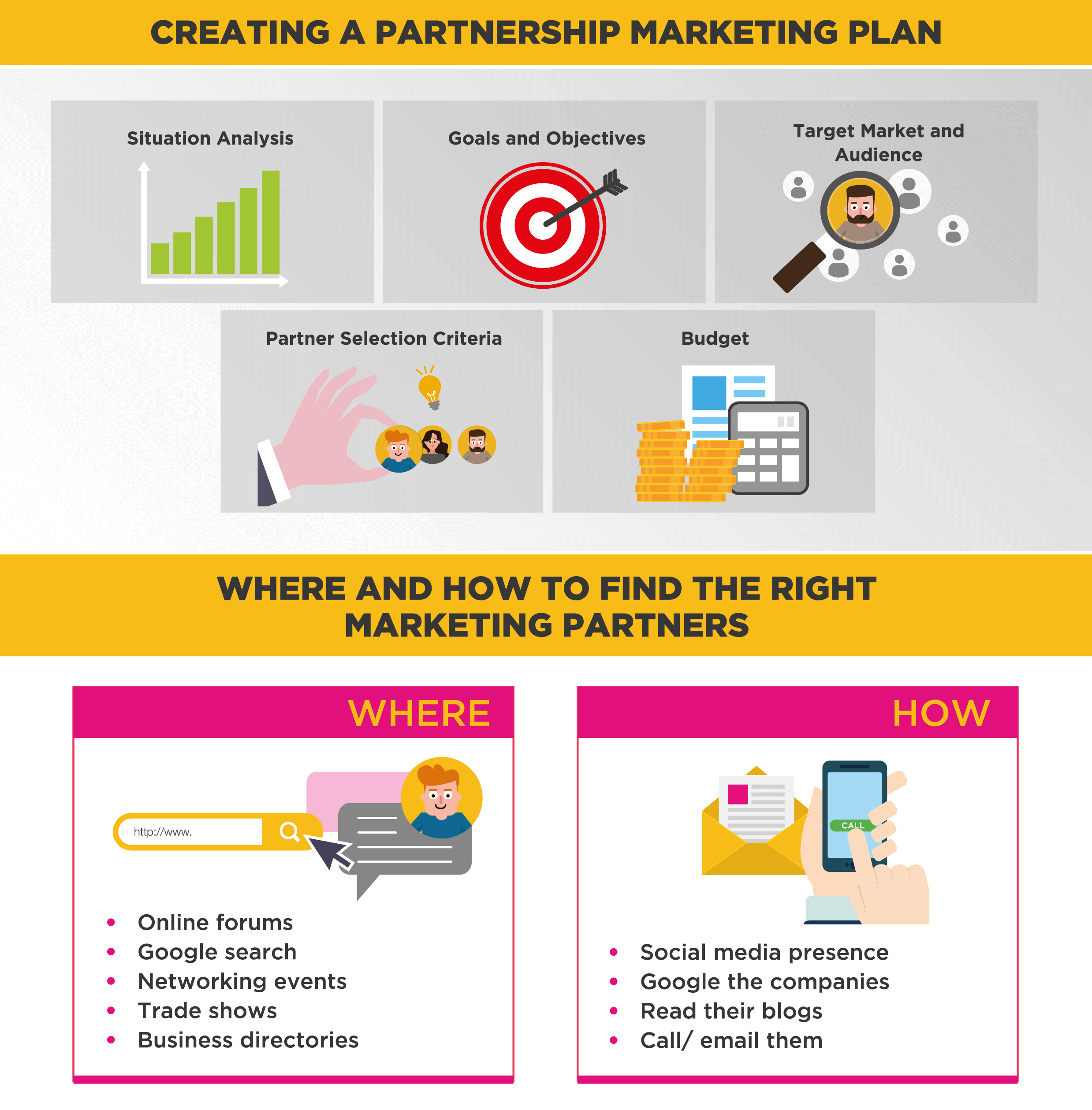
Situation Analysis
What is the current state of your small business? Are you just opening, or have you been open for a while? What current marketing approaches do you use? How have they worked so far? How strong is your brand currently? What challenges do you hope to overcome with partnership marketing? The answers to these and related questions should give you a solid understanding of where you are starting from.
Goals and Objectives
Conversely, this section will tell you where you want to go. How much do you want to grow your revenues? To what extent do you want to build your brand? Are you looking to grow your email list through partnership marketing? By how many subscribers? What does a successful campaign look like in terms of sales, awareness, donations, and other metrics?
Target Market and Audience
You probably already know your current market and audience well. But are they the ones you want to reach out to; or do you want to reach an entirely new audience? How is this new audience best reached? Where is it primarily located? What kind of messaging does this audience respond to? The better you can define your target market/audience, the easier it will be to pick the right partner.

Partner Selection Criteria
As the most important section in your partnership marketing plan, you should spend a good amount of time on selecting the right partner. What does your ideal partner look like? What type of business do they run? What are their brand characteristics? Are they hip, mature, risk-taking, cutting-edge? How big are they? How do they communicate with their audience? How big is their audience? By creating a comprehensive list of requirements, you can pinpoint just the right companies to partner with.
Budget
This could be a budget for upfront payments or commissions paid after a sale. Can you afford to pay commissions? Can your margins accommodate partnership marketing costs? Does partnership marketing make sense for your type of business and revenue model? Will potential sales from partners move the needle on your revenues? When filling in this section, you must be extremely level-headed to avoid overestimating potential returns.
With your plan in place, you are now ready to move to the next step, which is finding marketing partners. Before jumping to the next section, one last word on the partnership marketing plan – it will evolve. Expect each of the sections to change as your business and the business environment changes.Where and How to Find the Right Marketing Partners
Where
Although the obvious place most people look is online, offline sources can also yield some great partnership opportunities. Here is a quick list of where to find marketing partners:Online forums – These are a marketing goldmine, especially the ones that are industry-specific. You should not partner with a similar business to yours, so look for forums that attract businesses that are related and complementary but not similar to yours.
Google search – A good old Google search will help you find businesses either in your area or your niche that can be potential partners. Be careful to use complementary keywords and not similar ones.
Networking events – If you attend many of these or you know of such events in your area, they are also a great place to find partners.
Trade shows – Because of the variety and breadth of businesses that attend such events, you can easily find complementary businesses to partner with.
Business directories – Yellow Pages, Angie’s List, Yelp! are all great places to look for potential partners.
Now that you know where to look, how do you filter down so many potential partners to a handful you can approach and work with?How
Picking the right marketing partner requires preparations on your part, so you don’t end up working with a partner who is not a good fit. Here are some steps to take to sift through all the possible partners, and find one you can work with:Curate
From the various sources listed above, put together a list of businesses you admire and would love to partner with. Run this list through your best-fit partner selection criteria.
Competition
Is there any competitive overlap with the businesses you picked? For example, if you are targeting the same keywords, you probably would not be a good match.
Social media presence
Go through their social media with a fine tooth comb. Do they post often? What type of content do they post? Do their posts attract any engagement? Are they responsive to their followers?
Google the companies
Look for website quality, reviews, directory listings, videos, and anything else that can tell you more.
Read their blogs and subscribe to their newsletters
The type of content they publish will give you a good indication of how the company thinks, and what their priorities are.
Call/ email them
You don’t have to pitch them at this point. Instead, ask general questions: like whether they are open to partnerships, what kind of partnerships they have done in the past, and so on.
From these steps, you should ideally have around 10 – 15 companies you feel meet your requirements. While you may be tempted to move to the next step with a larger number, in the next section, we explain why working with a handful of high-quality partners is better.How to Work with Marketing Partners
Unlike other forms of marketing, partnership marketing is more of a dating game than a business transaction. Building strong partnerships takes time and involves a lot of relationship-building effort from both parties. With that in mind, what are the next steps to take now that you have a list of potential partners?Find the right person to talk to
Partnerships are a big decision at most companies, so finding the right person to speak with is essential. You can do this by calling up their business line and asking to be connected to someone who can help you with this.
Have a conversation
While you may be tempted to jump right into talking business, focus instead on starting a conversation. Discuss how your businesses can benefit from working together.
Prune your selection further
From these conversations, pick out the ones you got a good vibe from, who were excited to talk about the idea further and so on. Drop the rest.
Now that you have a great selection of potential partners, the next thing to do is create a proposal/contract. In it, outline how you see your businesses partnering, what benefits this will bring both parties, how this will be measured, how soon you see the partnership starting as well as the potential costs of the partnership. We should note here that some partnerships, such as affiliates, may use automated platforms and third-party affiliates so you may not need to go through all these steps. However, to build long-lasting one-on-one partnerships, you will need to follow these steps. If both parties agree, you can seal the deal by signing the contracts. Remember to include an exit clause, in case either party would like to dissolve the partnership. As you work together, focus on relationship-building; establishing synergies between your businesses and leveraging each other’s strengths.How to Measure and Manage Partnership Marketing Results
Measuring and managing results will tell you whether the partnership is working or not. Although cash returns will be the ultimate measure, broaden this to accommodate other metrics that may not be directly related to cash, but do affect your bottom line. Here are a few key metrics to look out for.Branding
A strong brand is worth more than a short-term spike in sales. As you partner up, do you see your brand strengthening? For example, if a partnership results in media mentions, this is a strong sign that the partnership is helping strengthen your brand. In addition, if you begin to see less churn in your customer base, it may be a sign that your customers perceive you as a valuable brand and keep buying from you.
Reach
Do more people know about your business as a result of the partnership? While strong sales should underpin this metric, having more people blogging about your business, or increased social media mentions can also be indicative of increased reach.
Content
The best marketing partnerships yield high-quality, memorable content. Think about the partnership between Red Bull and GoPro. It has consistently yielded extraordinary content since 2016, including the Stratos and Rampage campaigns. As a small business, your partnerships should produce high-value marketing content as well.
As you evaluate these metrics every week, look out for other ways you can leverage and optimize your existing partnerships. In addition, be ready to pull the plug on a partnership that either isn’t yielding results or is negatively impacting your business or brand.